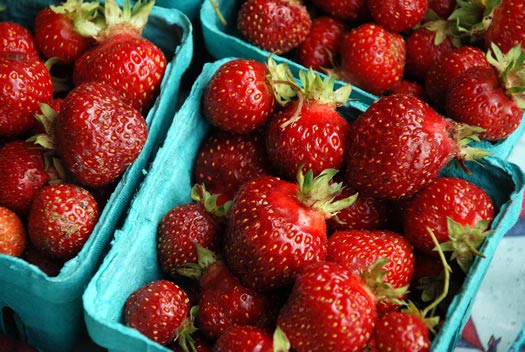In Season for June: Strawberries, Strawberries, Strawberries!
Happy June! This month’s In Season pick from Linda LaRue, creator of The Core Transformer and author of the SOUPer Slim Diet is strawberries. Oh, glorious June strawberries!

When I think of summer, I think of strawberries. The strawberry fruit was first mentioned in ancient Roman literature in reference to its medicinal use. The French began taking the strawberry from the forest to their gardens for harvest in the 1300s. Charles V, France’s king from 1364 to 1380, had 1,200 strawberry plants in his royal garden. In the early 1400s, Western Medieval European monks used the wild strawberry as red dye in their illuminated manuscripts!
Strawberries are the unsung (common and affordable) superfood. Several recent studies have found regular intake of strawberries to be associated with decreased risk of type 2 diabetes. In these studies, significant benefits were found when folks at ate a minimum of at least two to three one-cup servings of strawberries per week.
Researchers speculate that polyphenols (super food antioxidants) in strawberries play a major role in helping regulate your blood sugar response. One particular type of polyphenol in strawberries—ellagitannins—may be especially important for this blood sugar-relating benefit. Ellaginannins are a polyphenol that are known to inhibit the activity of an enzyme called alpha-amylase. Because this enzyme is responsible for breaking amylose starches into simple sugars, fewer simple sugars may be released into the blood stream, thus helping keep blood sugar levels low.
Strawberries are an excellent source of antioxidant-promoting vitamin C and manganese. In fact, one cup of strawberries provides 163 percent of your daily recommended dose of Vitamin C. They are rich in B-complex vitamins including vitamin B-6, niacin, riboflavin, pantothenic acid, folic acid and folate, which is important for pregnant women. These vitamins act as co-factors to assist the body to metabolize carbohydrate, proteins and fats. Plus, strawberries are a good source of potassium, magnesium, vitamin K and thyroid health-promoting iodine. And at only about 50 calories per cup with zero fat, they’re a sweet treat that won’t bust your diet.
Types of Strawberries
Chandler: Patented in 1979, Chandler is a longtime favorite; a juicy and tender berry found at most farmers’ and local markets. Sadly, most commercial growers long ago moved onto firmer, higher yielding varieties making them harder to find each year at most local farmers markets.
Seascape Strawberries and Gaviotas: Developed in the early 90s, Seascape Strawberries have a refreshing acidity and good—not great—flavor because they lack the complexity that the best varieties have, such as my favorite low-acid and very sweet Gaviotas made famous by Harry Berry’s. Seascapes are pretty popular at most local markets. However, they do tend to turn dark and soft very quickly.
Camarosa: The Camarosa is a more recently developed variety that ripens earlier than most other strawberry types. They are firmer and more dry and crunchy than most other varieties—and are my least favorite type.
How to Buy Strawberries
Aroma is usually, but not always, a reliable indicator of quality. If you walk by a stand and can smell the berries, well, that’s a very promising sign. Even when the weather is fine, the same variety from the same grower will be super sweet and delicious one week, and bland or sour two weeks later. The only way to know if the strawberries that you intend to purchase taste great is to try one, which most vendors will happily provide; but often they hand out the ripest berries to attract buyers. That’s why I recommend sampling a berry from the pint or quart that you intend to buy. As strawberries do not ripen after picking, avoid baskets with a lot of unripened white and/or green spots on them. Avoid berries that have dark spots and mold because they will contaminate the other berries within (yikes) hours!
How to Store Strawberries
Strawberries are highly perishable with a short shelf life of only a couple days, so it’s best to buy them only when you plan to immediately eat them. Store them in an airtight rubber container and refrigerate immediately after purchase.
How to Prepare Fresh Strawberries
Since they are very perishable, strawberries should not be washed until right before eating or using in a recipe. Do not remove their caps and stems until after you have gently washed the berries under cold running water and patted them dry. My favorite way to eat strawberries is sliced or whole. Period.
But just in case you’re looking for a new way to enjoy in season strawberries, come back tomorrow for my Low-Calorie, Low-Sugar Strawberry Pavlova recipe. It’s delicious—and a great way to make use of a bunch of fresh strawberries!
Tell me: What’s your favorite way to enjoy strawberries? —Linda
